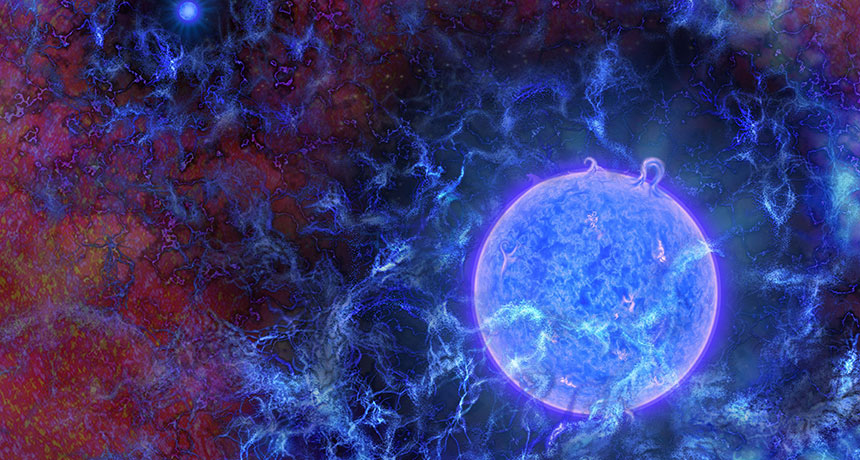alt cosmology paper reinvents the big crunch

Extending my previous note on the state of many papers submitted to arXiv today, the view hungry editors at the Technology Review blog decided to do a very, very generous write-up for a paper that predicts a universe with no Big Bang and while explaining a few odd observations related to certain supernovae, forgets to make any provision for major cosmological events which serve as the evidence for the very Big Bang it’s trying pretty hard to avoid. And you know it’s going to be a review made of five parts hype to one part science when you see sensationalistic and disingenuous sentences like this in the opening paragraph:
And while there is scientific consensus that it is the best explanation for the origin of the Universe, the debate is far from closed. However, it’s hard to find alternative models of the Universe without a beginning that are genuinely compelling.
Debate about what exactly? We’re pretty confident that the universe began with a single event and the problem is figuring out exactly what this event was and what role it plays in the grand scheme of things. Yes, it’s a really big problem but there are very few scientists out there debating whether the Big Bang is or isn’t real. And if the quest for an alternative theory for the origin of our universe is so lackluster, shouldn’t it say something about a problem with arguments against the Big Bang model and indicate that there really isn’t much debate? I mean what could we debate if we have no real alternatives? This is why the post quickly moves on to an introduction of the paper it’s going to advertise as potentially compelling, manufacturing its importance in the intro.
Shu’s idea is that time and space aren’t independent entities but can be converted back and forth between each other. In his formulation of the geometry of spacetime, the speed of light is simply the conversion factor between the two. Similarly, both mass and length are interchangeable in a relationship in which the conversion factor depends on both the gravitational constant G and the speed of light, neither of which need be constant.
Ah, so once again, if we convert mass to height, divide it by width, crisscross it with the weak nuclear force by the factor of Newton’s law of fudge, then take this through left clavicle, past the left ventricle, and to grandma’s house, we’ll have a brand new universe. While there’s a well known relationship between space and time via the speed of light, an idea that Technology Review mistakenly attributes to Shu rather than Einstein who really may have gotten the idea from Poincare, the exchange between mass and length via G and the speed of light seems very clunky and comes from a complex blizzard of math rather than cited experimental data. And while his newly created mathematical redefinition of the universe can explain why the universe is expanding, neatly doing away with singularities of any type in the process, it does have a major weak spot…
That’s not to say Shu’s theory is perfect…. One of the biggest problems he faces is explaining the existence and structure of the cosmic microwave background, something many astrophysicists believe to be the the strongest evidence that the Big Bang really did happen. The CMB, they say, is the echo of the Big bang. How it might arise in Shu’s cosmology isn’t yet clear but I imagine he’s working on it.
Wait a second. We have an alternative cosmology that doesn’t explain CMBR? That’s kind of like a new theory of particle physics that doesn’t explain electrons and quarks. Sure, through some numerology, Shu makes his model of the universe expand and contract like a vibrating coil, but he can’t explain why it’s contracting without any trigger, simply resorting to an eternal universe that constantly oscillates like a Big Crunch that never gets to actually crunch itself. In fact, the Big Crunch does a much better job in explaining the same thing as Shu, as well as accounting for the CMBR. Unfortunately, the universe seems to be expanding too fast to later slow and fall in on itself, starting another cycle via a Big Bang. For all the mathematical huffing and puffing, and attention his work received on the web, Shu hasn’t done anything new other than figured out another way to reformat the abandoned theory of the Big Crunch and the editor who wrote up the ad for his paper was painfully unaware of this fact while gushing with praise about its implications.
This is why it’s a bad idea to write about “groundbreaking” and “revolutionary” and papers based on what just caught your eye in the arXiv repository, rather than something accepted by a serious peer reviewed journal, or being taken seriously by the cosmological community. I know what you’re thinking, all new ideas have to come from somewhere, right? Yes, but keep in mind that anybody can post anything to arXiv because it’s not a peer reviewed site and the papers aren’t vetted by experts. It’s just a place to put up something and get a little press for your efforts. Until actual experts have a chance to look at it and there’s real evidence for its conclusions that can be seen in colliders or in astronomical snapshots, getting too excited over what it means to the universe and the scientific community is premature at best and irritating at worst.
See: Wun-Yi Shu (2010). Cosmological Models with No Big Bang, arXiv: 1007.1750v1





